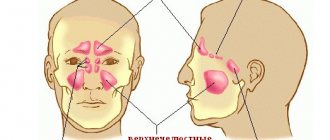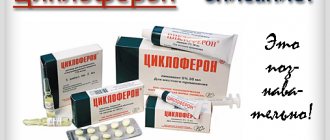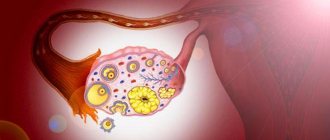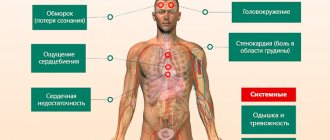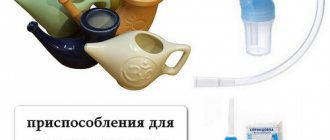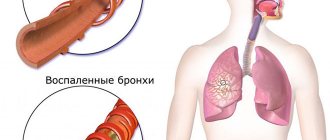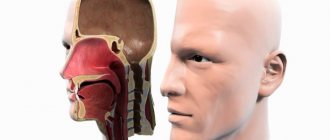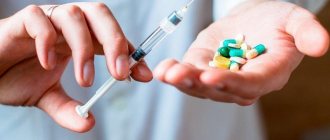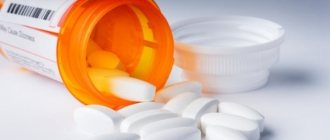Main aspects of treatment of sinusitis
.
Before you start using an antibiotic for sinusitis, you need to diagnose:
- Bacterial culture and its causative agent (to understand the nature of the disease, as well as the type of microorganisms that caused purulent sinusitis).
- Antibioticogram (a new procedure for determining the sensitivity of microorganisms to antibiotics). When the diagnosis is completed, the doctor will prescribe a suitable drug for the disease.
Treatment of the disease should be started if the patient:
- Pain in the eye sockets and frontal lobes.
- Pressing sensation in forehead and nose.
- High body temperature (we are talking about an acute form of purulent sinusitis, since a chronic patient will not have a fever).
- A significant amount of pus is released.
- Difficulty breathing through the nose, especially at night.
- Systematic migraines, symptoms of sinusitis, which are not relieved even by potent medications.
- When tilting the head to the sides or to the sides, the patient feels pain and discomfort every time. He feels pressure on certain parts of his face.
If you refuse timely therapeutic treatment, the disease can not only become chronic, but also negatively affect the human brain. The ending may have irreversible complications and outcome.
7 days after the manifestation of the pathology, the doctor decides to prescribe antibiotic therapy. It is carried out when neither inhalation procedures nor nasal rinsing have brought any effective effect.
Only a specialist can prescribe medication. Self-medication is excluded, since antimicrobial medications can provoke the development of side effects, such as otitis media, bronchitis and others. Their consequences will be irreparable.
Any methods of treating the disease should be aimed at achieving:
- Relief from inflammation in the sinuses.
- Increased outflow of nasal secretions that have formed due to the inflammatory process.
- Reducing swelling of the sinus and nasal mucosa.
- Minimizing pain.
HELP: you can recover from sinusitis only under the supervision of your doctor. You can’t treat yourself!
According to the standard, the disease is treated with medication. Doctors resort to surgery only when other options have not brought the desired result.
If inflammation begins due to the development of pathogenic microflora, antibacterial drugs are used. They actively contribute to the relief of nasopharyngeal disease, but their disadvantage is the possible harm to the patient’s gastrointestinal tract. Especially if you use them over a long period of time.
The use of this type of medication has many other disadvantages:
- Pathogenic microorganisms quickly “get used” to antibacterial substances.
- Today, markets produce a huge number of fakes.
- If the patient faces a problem with normal blood circulation, antibiotics begin to act less effectively.
In addition, medications with this effect usually cannot be taken during pregnancy and breastfeeding.
Contraindications to the use of antibiotics
Conditions when a medicine for sinusitis in adults or children does not provide a therapeutic effect and may be dangerous are called contraindications. Each antibiotic has its own specifics, so it is necessary to take into account all factors that can negatively affect health.
When prescribing antibiotics, anamnesis of the disease is important, that is, collecting information about previous diseases, medications, their positive and negative effects.
List of contraindications:
- Kidney and liver diseases. The effect of antibiotics on chronic diseases is negative;
- Childhood;
- Allergy;
- Pregnancy and lactation, when the female body is most sensitive to the effects of chemical compounds.
Antibiotics are especially dangerous in the first trimester (possible termination of pregnancy). It is allowed to use medications if there is a threat to the life of the mother or fetus. During lactation, taking medications, you need to stop breastfeeding.
It is unacceptable to drink alcohol together with antibiotics. It causes nausea, vomiting, convulsions, and can be fatal.
Therefore, only a doctor will decide which antibiotics to take for sinusitis. He will be guided by the individual characteristics of the patient, possible manifestations of allergic reactions, and concomitant chronic diseases. The main thing is to prescribe adequate treatment, according to the laboratory and clinical examination.
Treatment of sinusitis without antibiotics
It is possible to treat sinusitis without medication for both children and older people, because there are many different folk recipes.
When the disease has just begun to progress, you can:
- rinse your nose with saline, sea salt or herbal decoction. Rinse should be repeated about 4 times a day;
HELP: do not perform the nasal rinsing procedure if at least one nostril is clogged! In such a situation, you first need to relieve the swelling.
- Drainage of the paranasal sinuses is effective for the disease. The nasal passages need to be moistened with a herbal medicinal solution (you need to use pre-moistened cotton swabs, holding them in the nose at a depth of 1 cm for 5 minutes). Every 2 minutes you need to turn them easily, then leave them in a stationary position again. When this is done, you should forcefully blow the air out of your nostrils, then cover your nose and mouth with your hands and take a strong breath through your nose. To prepare a herbal decoction, take St. John's wort, chamomile, cedar and gum solution in a ten percent proportion;
- If there is no disturbance in the outflow of green mucus from the sinuses, you can lubricate the inside of the nose with a warming ointment containing tetracycline at night.
Treatment with antiviral tablets
Quite often, the cause of sinusitis is a viral infection. Harmful agents, penetrating the nasal passages, begin to multiply rapidly, which contributes to the development of inflammation. As a result, snot flows profusely, congestion and lacrimation appear. In this case, the use of antiviral drugs that increase the body's defenses is indicated. The most famous and most effective are:
- "Arbidol";
- "Oscillococcinum";
- "Isoprinosine";
- "Aflubin";
- "Amiksin".
Oscillococcinum
Arbidol
When are antibacterial drugs necessary?
It happens that a disease, without a fungal or allergic pathogen, has the most negative effect on the patient, rapidly progressing.
Then it is worth resorting to the use of anti-inflammatory antibiotics.
For what symptoms can a doctor prescribe this or that drug?
- Continuous sharp pain in the nose.
- Increased body temperature.
- Deterioration of a person’s overall health due to severe intoxication.
- Pus from the nasal cavity.
- Severe migraines.
Sometimes antibiotics are not used. But if the patient’s condition continues to worsen and the pain does not go away, one should be treated with modern types of medications for sinusitis in the form of pills, sprays or punctures.
How to choose the right drug?
Only an experienced otolaryngologist should make the correct selection of tablets for sinusitis in each specific situation. In any case, antibiotics are the mainstay of treatment. The rest of the above drugs can be prescribed for appropriate symptoms after studying the medical history, examining the patient and obtaining test results.
The frequency of administration and the required dose are also selected by the attending physician. Without the doctor's permission, it is strictly forbidden to cancel prescribed medications or take new medications, since without medical assistance the patient will not be able to correlate all the possible risks to his health. Even the most effective, but incorrectly selected antibiotic against sinusitis can cause great harm to the body.
Antibiotics for sinusitis in children
The effectiveness of tablets for sinusitis for the younger generation appears two days after the treatment process has begun.
The temperature should return to normal, the main symptoms should disappear, migraines will also stop, and the child’s overall health will improve.
Manufacturers now produce medications in various forms for children. The final decision is made by the attending physician after assessing the child’s general condition and the properties of the most optimal antibiotic options:
- Drops and sprays for internal use (the most inexpensive method). They are recommended for use during a long-term inflammatory process, when it all comes down to the fact that sinusitis will eventually develop. Children are prescribed the drug 1 dose in each nostril 3 times a day. Sprays are not prescribed to babies under one year of age.
- Capsules and dragees. Used as soon as the first symptoms and complaints appear. Doses and duration of use are determined depending on how old the child is. They are prescribed from six to seven years of age. Younger children simply will not be able to physically swallow the pills. In addition, there is a risk that you will develop an allergy to the components of the tablets.
- Suspensions. These packages with powder inside are as effective as pills. In this form, the antibacterial agent is used to treat very young babies. They are diluted with warm purified water. The dosage should be viewed in the instructions for use, which are included as standard. You should also focus on the child’s weight.
- Punctures. Their introduction is resorted to if the form of sinusitis has become severely aggravated, and all other procedures are ineffective. The medication is absorbed into the blood, bypassing the gastrointestinal tract. Has an immediate bactericidal effect. It is so effective that results can be seen within two days.
- Carrying out inhalations for children. To carry out this procedure, you will need a special inhaler. A compression inhaler is required for this. Used to treat nasal sinusitis. It is also used for the therapeutic treatment of mild forms of sinusitis. This way, parents will be able to achieve an expectorant and anti-edematous effect.
REFERENCE: the injection procedure with antibacterial agents for this disease can provoke allergies in children. In this regard, IV drips should be placed exclusively in stationary conditions in a medical clinic.
The main contraindication to the use of drugs is the patient’s intolerance to at least one of the components of the antibiotic. If a child has a chronic form of liver, kidney and stomach diseases, the pediatrician undertakes to adjust the dosage.
System
This kind of antibiotics is prescribed only after laboratory tests have been carried out to determine the sensitivity of microorganisms to drugs. The task of systemic antibiotics is to prevent the development of complications and suppress the growth and reproduction of bacteria.
The process of culturing organisms and conducting research takes up to a week, and treatment must be prescribed immediately. In such cases, the drug is chosen based on medical experience. Popular pathogens are taken into account.
Amoxicillin capsules
The most commonly used group is penicillins.
- "Amoxicillin" (we have already mentioned it). A common drug with a wide spectrum of action. It has one drawback - some types of bacteria can destroy it, and then there will be no effect from taking it. It has the following analogues: “Flemoxin Solutab”, “Hiconcil”, “Ospamox”. Available in tablet form. The duration of treatment is no more than 2 weeks, long-term use only as prescribed by a doctor. Use 250 mg 3 times a day for children over five years of age, and 500 mg for adults with the same frequency.
- "Amoxiclav" (see above). Active ingredients: amoxicillin and clavulanic acid. The peculiarity of the drug is the presence of protection against bacteria that penicillins destroy. It has analogues: “Amoclav”, “Augmentin”, “Flemoklav”. It is produced in the form of tablets and suspensions with different flavors for children. The choice of drug belongs to the patient, based on cost and manufacturer. Adults and children over 12 years of age take up to 500 mg 3 times a day, children are given a suspension, the dosage is calculated based on weight and age. Duration of treatment is up to 14 days.
Macrolides. The peculiarity of antibiotics is low toxicity. They are able to penetrate deeply into the bacterial cell and influence the pathogen. More suitable for treating children.
- Azithromycin. It is used in case the patient is allergic to the penicillin group. The dosage for adults is 500 mg per day for 3 days, for children – 10 mg per 1 kg of weight per day in one dose.
- "Sumamed." The main active ingredient is azithromycin. The effectiveness of antibiotic use has been confirmed by a number of studies, which has affected the cost of the medicine. Analogues: “Hemomycin”, “Zitmak”. Take in the same way as Azithromycin.
- "Klacid." Clarithromycin is the basis of the drug. Broad-spectrum antibiotic. Adults take 500 mg per day for 3-5 days.
Cephalosporins. Antibiotics of the 1st, 2nd and 3rd generations, which are used to treat sinusitis.
- "Ceftriaxone". The third generation drug is administered intramuscularly. Usually used with Lidocaine, as the injection is painful. The course of treatment is 5-7 days with a dosage of 1 g 2 times a day.
Tetracyclines. In the treatment of sinusitis they are rarely used, only if the pathogen is sensitive to the antibiotic.
- "Doxycycline." Produced in the form of capsules and tablets. Take the drug for 5-7 days, 100 mg 1-2 times a day.
Which antibiotic to choose, in what form, and how to take it, is decided only by the attending physician, taking into account the severity of the disease and the wishes of the patient.
What antibiotics to take for sinusitis in adults?
Antibiotics for sinusitis in adults are prescribed by the attending physician, depending on the form of the disease.
Often, the empirical treatment of mild to moderate disease begins with Amoxicillin.
If after three days nothing improves, you should switch from this drug to clavulanic acid.
Alternatively, Ceftriaxone and Cefuroxime are used.
If improvements occur, the patient is prescribed cephalosporins for oral administration.
If the inflammation of the sinuses does not go well, they are changed to fluoroquinolones.
If there is a risk of an allergic reaction, as well as contraindications to the use of all of the above, macrolides are used.
Systemic antibiotics for sinusitis
Systemic antibacterial drugs are prescribed if therapeutic treatment is carried out in combination. Direct indications for their use (list):
- Acute progressive form of catarrhal sinusitis.
- There is a lot of pus when the nose is very stuffy.
- Severe pain that is accompanied by migraines and discomfort in the maxillary sinuses.
- Intoxication.
- Long-term, unremitting sinusitis.
- Types of complications due to the disease.
- A collection of certain symptoms.
Penicillins without and with clavulanates
Many antibacterial drugs have been developed that contain or do not contain clavulanic acid. This allows penicillins not only to inhibit the functions of bacteria, but also to completely destroy them. This significantly helps in the treatment of acute sinusitis and its chronic form.
Amoxicillin, as one of the older types of antibiotics, is used less and less for the treatment of adults. However, it is popular in treating children whose bodies are not yet familiar with a large number of bacteria and are not yet so strong.
It has been mentioned more than once that bacteria constantly adapt. Old antibacterial drugs may no longer be effective due to the fact that bacteria have developed resistance to them. The same thing happened with Amoxicillin, which no longer has an effect on many bacteria that provoke an acute form of sinusitis.
The development of new drugs pushes into the background those drugs that helped previously. Unprotected antibiotics are no longer popular, since protected drugs have fewer contraindications and practically no side effects. This is good when treating not only adults, but also children.
go to top
